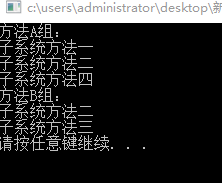意图:
为子系统中的一组接口提供一个一致的界面,此模式定义了一个高层接口,这个接口使得这一系统更加容易使用。
适用性:
1、在设计初期阶段,应该要有意识的将不同的两个层分离,比如经典的三层架构,就需要考虑在数据访问层和业务逻辑层、业务逻辑层和表示层的层与层之间建立外观。
2、在开发阶段,子系统往往因为不断的重构演化而变得越来越复杂,大多数模式使用时也都会产生很多很小的类,这本是好事,但也给外部调用他们的用户程序带来了使用上的困难,用外观模式提供一个简单的接口,减少他们之间的依赖。
3、在维护一个遗留的大型系统时,可能这个系统已经非常难以维护和扩展了,但因为它包含非常重要的功能,新的需求开发必须要依赖于它。此时为新系统开发一个外观类,来提供设计粗糙或高度复杂的遗留代码的比较清晰简单的接口,让新系统与外观对象交互,外观对象与遗留代码交互所有复杂的工作。
代码实现:
1 // Facade.cpp : 定义控制台应用程序的入口点。 2 // 3 4 #include "stdafx.h" 5 #include<iostream> 6 #include <string> 7 using namespace std; 8 9 class SubSystemOne 10 { 11 public: 12 void MethodOne() 13 { 14 cout<<"子系统方法一"<<endl; 15 } 16 }; 17 18 class SubSystemTwo 19 { 20 public: 21 void MethodTwo() 22 { 23 cout<<"子系统方法二"<<endl; 24 } 25 }; 26 27 class SubSystemThree 28 { 29 public: 30 void MethodThree() 31 { 32 cout<<"子系统方法三"<<endl; 33 } 34 }; 35 36 class SubSystemFour 37 { 38 public: 39 void MethodFour() 40 { 41 cout<<"子系统方法四"<<endl; 42 } 43 }; 44 45 class Facade 46 { 47 private: 48 SubSystemOne *one; 49 SubSystemTwo *two; 50 SubSystemThree *three; 51 SubSystemFour *four; 52 public: 53 void MethodA() 54 { 55 cout<<"方法A组:"<<endl; 56 one->MethodOne(); 57 two->MethodTwo(); 58 four->MethodFour(); 59 } 60 void MethodB() 61 { 62 cout<<"方法B组:"<<endl; 63 two->MethodTwo(); 64 three->MethodThree(); 65 } 66 67 }; 68 69 int _tmain(int argc, _TCHAR* argv[]) 70 { 71 Facade *fade = new Facade(); 72 fade->MethodA(); 73 fade->MethodB(); 74 system("pause"); 75 return 0; 76 }

具体实现参考程洁的《大话设计模式》